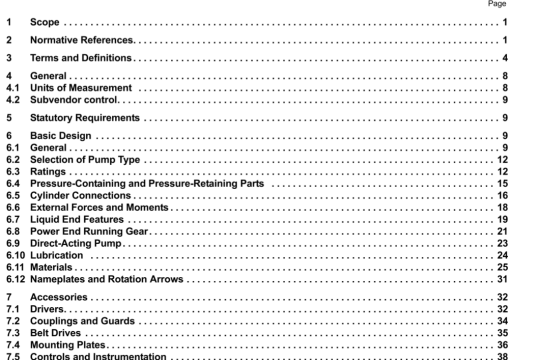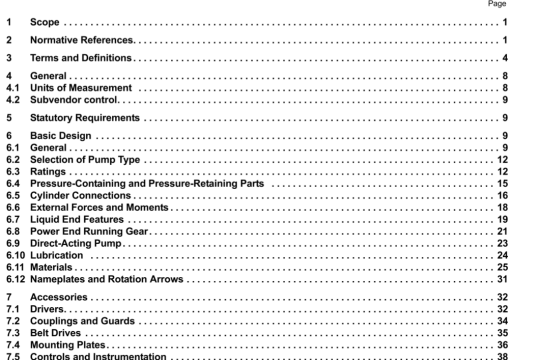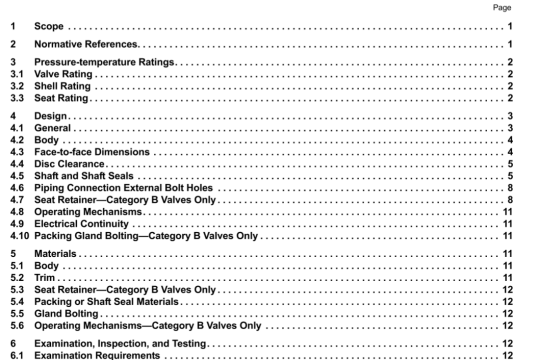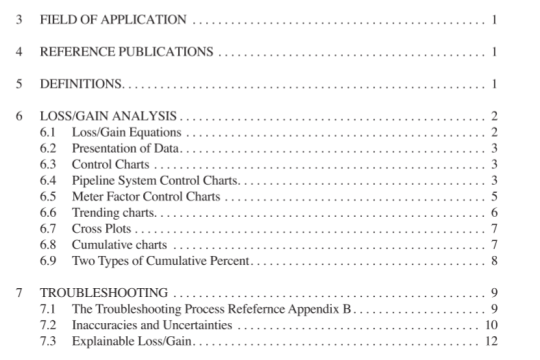API STD 618:2010 pdf download
API STD 618:2010 pdf download.Reciprocating Compressors for Petroleum, Chemical, and Gas Industry Services.
3.27 minimum allowable temperature: The lowest temperature for which the manufacturer has designed the equipment (or any part to which the term is referred).
3.28 mode shape (of an acoustic pulsation resonance): The description of the pulsation amplitudes and phase angle relationship at various points in the piping system. Knowledge of the mode shapc allows the analyst to understand the pulsation patterns in the piping system (see 3.1).
3.29 mounting plate: Baseplates. skids. soleplates. and rails.
3.30 normal operating point: The point at which usual operation is expected and optimum efficiency is desired. This point
is usually the point at which the manufacturer certifies that performance is within the tolerances stated in this standard.
3.31 normally open and normally closed: Refers both to the on-the-shelf state and to the installed, dc-energized state of devices such as automatically controlled electrical switches and valves.
Note: The normal operating state of such devices is not necessarily the same as the on-the-shelf state.
3.32 normative: A requirement to be met in order to comply with the standard.
3.33 observed: An inspection or test where the purchaser is notified of the timing of the inspection or test and the inspection
or test is performed, as scheduled, even if the purchaser or the purchaser’s representative is not present.
3.34 owner: The final recipient of the equipment.
Note: In many instances the owner delegates another agent to be the purchaser of the equipment.
3.35 panel: An enclosure used to mount, display, and protect gauges, switches and other instruments.
3.36 passive analysis: A portion of the acoustic simulation in which a constant flow amplitude modulation over an arbitrary frequency range is imposed on the system. normally at the cylinder valve locations. The resulting transfer function defines the acoustic natural frequencies and the mode shapes over the frequency range of interest (see 3.1).
3.37 piston rod drop: A measurement of the position of the piston rod relative to the measurement probe mounting location(s) (typically oriented vertically at the pressure packing on horizontal cylinders).
3.38 piston rod runout: The change in position of the piston rod in either the vertical or horizontal direction as measured at
a single point (typically at or near the pressure packing case) while the piston rod is moved through the outbound portion of its
stroke.
Note 1: In horizontal compressors, the piston rod runout is measured in both the vertical and horizontal directions. Horizontal runout is taken on
the side of the rod to determine horizontal variations, while vertical runout is taken on the top of the rod to determine vertical variations. Note 2: Practical considerations make it advisable to monitor the runout measurements while rotating the shaft through one complete revolution. Note 3: See Annex C for a detailed discussion of piston rod runout.
3.39 pressure casing: The composite of all stationary pressure containing parts of the unit, including all nozzles and other attached parts.
3.40 pressure design code: The recognized pressure vessel standard specified or agreed upon by the purchaser. Example:
A recognized standard for pressure vessels is ASME Section VIII.
3.41 purchaser: The agency that issues the order and specification to the vendor.
Note: The purchaser may be the owner of the plant in which the equipment is to be installed or the owner’s appointed agent.
3.42 rails: Soleplates extending the full length of each side of the equipment.
3.43 rated discharge pressure: The highest pressure required to meet the conditions specified by the purchaser for the intended service.
3.44 rated discharge temperature: The highest predicted operating temperature resulting from any specified operating condition.
3.45 rated speed: The highest rotational speed required to meet any of the specified operating conditions.3.46relief valve set pressure: The pressure at which a relief valve starts to lift.
3.47remote:The location of a device when located away from the equipment or console, typically in a control room.
3.48required capacity: The process capacity specified by the purchaser to meet process conditions, with no-negative-tolerance (NNT) permitted.
Note 1: The required capacity is the quantity of gas taken into the compressor cylinder at the specified inle conditions while the compressor isoperating at the specified discharge pressure and speed.
Note 2: See Annex B for an explanation of the term no-negative tolerance.
3.49 rod reversal: A change in direction of force in the piston rod loading (tension to compression or vice-versa), whichresults in a load reversal at the crosshead pin during each revolution.
3.50 settling-out pressure: The pressure within the compressor system when the compressor is shut down withoutdepressuring of the system.




